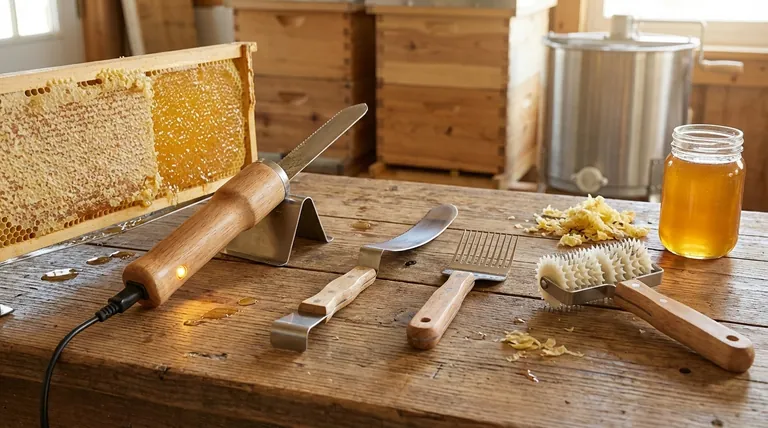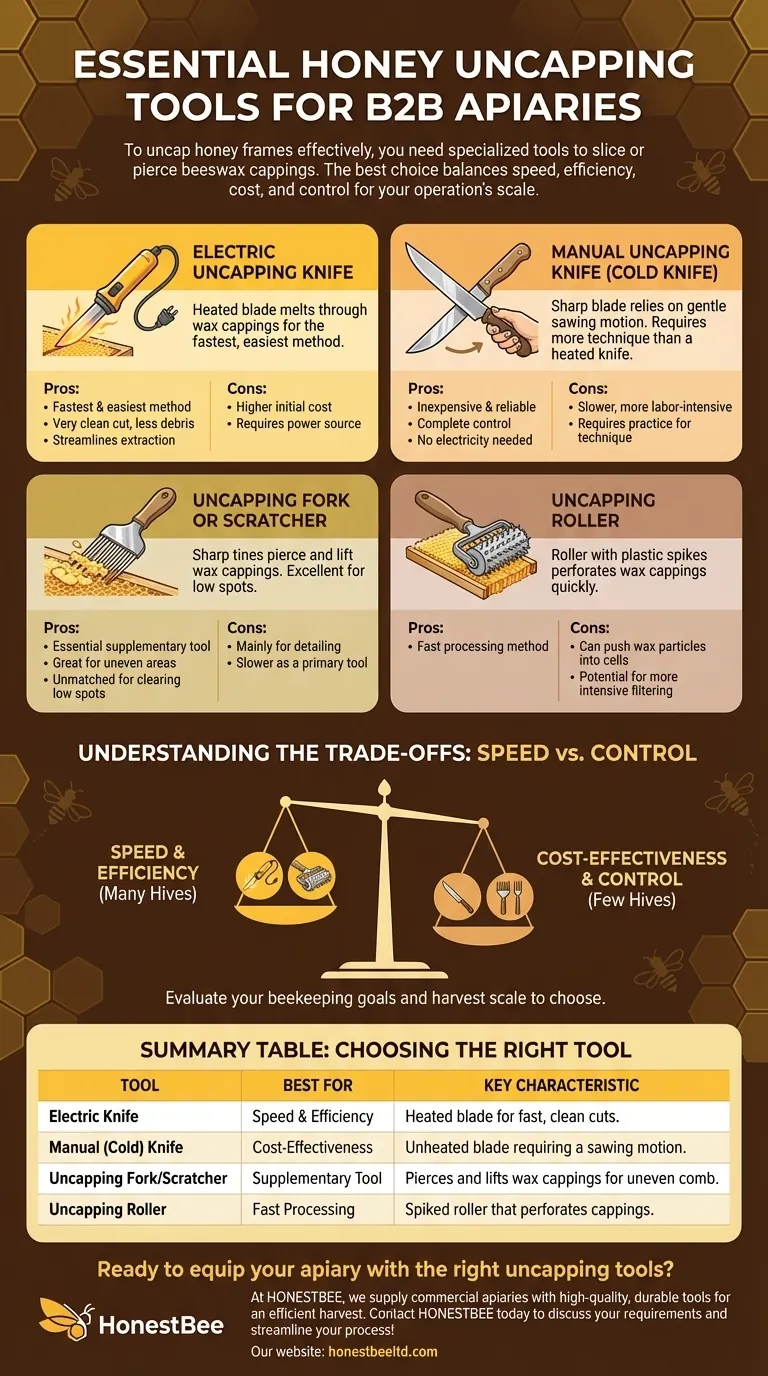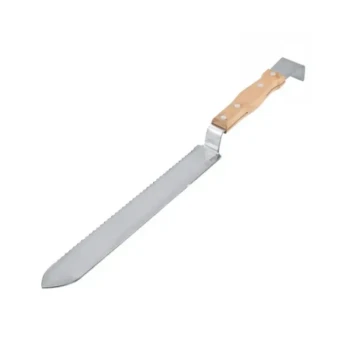To uncap honey frames effectively, you need a specialized tool designed to slice or pierce the beeswax cappings that seal the honeycomb cells. The essential tools mentioned for this task are an electric uncapping knife, a manual (or "cold") knife, an uncapping fork or scratcher, and an uncapping roller. Each serves the same core purpose but is suited for different scales of operation and beekeeper preferences.
The best uncapping tool isn't a single item, but rather the one that best matches the size of your beekeeping operation. Your choice balances the need for speed and efficiency against factors like cost, control, and simplicity.

A Closer Look at Each Uncapping Tool
While the goal is always the same—to cleanly remove the wax cappings—the method for achieving it varies significantly between tools. Understanding how each one works is the first step in selecting the right one for your apiary.
The Electric Uncapping Knife
An electric knife features a heated blade that melts through the wax cappings as you slice. This is widely considered the fastest and easiest method.
The heat allows the blade to glide smoothly, providing a very clean cut. This efficiency means less wax debris ends up in your honey, simplifying the filtering process later.
The Manual Uncapping Knife (Cold Knife)
A manual or "cold" knife is a long, sharp blade that relies on a gentle sawing motion to slice through the cappings. It requires more technique than a heated knife.
The key is to use quick, back-and-forth motions while applying minimal downward pressure. You want to shave off just the cappings, going only "skin deep" to avoid cutting into the honeycomb structure itself.
The Uncapping Fork or Scratcher
This tool has sharp metal tines, resembling a fork or a comb, used to pierce and lift the wax cappings off the cells.
It is especially useful for uncapping low spots or uneven areas on the comb that a knife might miss. Many beekeepers use a fork as a secondary tool to complement their primary knife.
The Uncapping Roller
An uncapping roller is a tool with a handle attached to a roller covered in small plastic spikes. As you roll it over the comb, the spikes perforate the wax cappings.
This method is fast but can push more wax particles down into the cells, potentially making the honey filtering process more intensive.
Automatic Uncappers
For very large, commercial-scale operations, automatic uncappers exist. These are complex machines that process frames with minimal manual input. They are not practical or necessary for hobbyist or small-scale beekeepers.
Understanding the Trade-offs: Speed vs. Simplicity
Your decision ultimately comes down to a trade-off. Do you prioritize the speed of processing many frames, or do you prefer the low-cost simplicity of manual tools for a smaller harvest?
The Case for Heat and Speed
An electric knife is the clear winner for efficiency. If you have more than a few hives, the time saved during the harvest can be substantial. The cleaner cut also streamlines the rest of your honey extraction workflow.
The primary downsides are the higher initial cost and the need for a power source in your honey processing area.
The Case for Manual Control
Cold knives and forks are inexpensive, reliable, and give you complete control. They require no electricity and are perfect for beekeepers with only a handful of hives.
The main drawback is that they are slower and more labor-intensive. It takes practice to develop the right technique for a clean, efficient cut with a cold knife.
Choosing the Right Tool for Your Apiary
To make a final decision, evaluate your own beekeeping goals and the scale of your harvest.
- If your primary focus is speed and efficiency (many hives): An electric uncapping knife is your best investment for its fast, clean cuts that simplify the entire extraction process.
- If your primary focus is cost-effectiveness and control (a few hives): A manual "cold" knife combined with an uncapping fork offers a reliable, affordable, and highly effective solution.
- If your primary focus is dealing with uneven frames: An uncapping fork or scratcher is an essential supplementary tool to own, regardless of which knife you choose, as it is unmatched for clearing low spots.
Ultimately, the right tool is the one that allows you to uncap your honey with confidence and minimal disruption to the comb.
Summary Table:
| Tool | Best For | Key Characteristic |
|---|---|---|
| Electric Knife | Speed & Efficiency (Many Hives) | Heated blade for fast, clean cuts |
| Manual (Cold) Knife | Cost-Effectiveness & Control (Few Hives) | Unheated blade requiring a sawing motion |
| Uncapping Fork/Scratcher | Supplementary Tool for Uneven Comb | Pierces and lifts wax cappings |
| Uncapping Roller | Fast Processing | Spiked roller that perforates cappings |
Ready to equip your apiary with the right uncapping tools?
At HONESTBEE, we supply commercial apiaries and beekeeping equipment distributors with the high-quality, durable tools needed for an efficient harvest. Whether you're scaling up with electric knives or need reliable manual tools, our wholesale-focused operations ensure you get the right equipment for your specific needs.
Contact HONESTBEE today to discuss your uncapping tool requirements and streamline your honey extraction process!
Visual Guide

Related Products
- Professional Z-Shaped Multi-Function Uncapping Knife for Beekeeping
- Professional Extra-Wide Uncapping Fork with Bent Tines for Beekeeping
- Honeycomb Uncapping Knife for Apiculture
- Electric Heated Honey Uncapping Knife for Beekeeping
- Stainless Steel Dual Blade Uncapping Plane
People Also Ask
- How does comb depth affect the efficiency of uncapping tools? Match Your Tool for a Faster Harvest
- What is the benefit of the serrated edge on an uncapping knife? Unlock Faster, Cleaner Honey Extraction
- How to clean an uncapping knife? Master the Hot-Knife Method for Easy Maintenance
- How does a cold knife assist in the uncapping process? Master Efficient Honey Harvesting
- What is the use of an uncapping knife? Master the First Step of Honey Harvesting



















